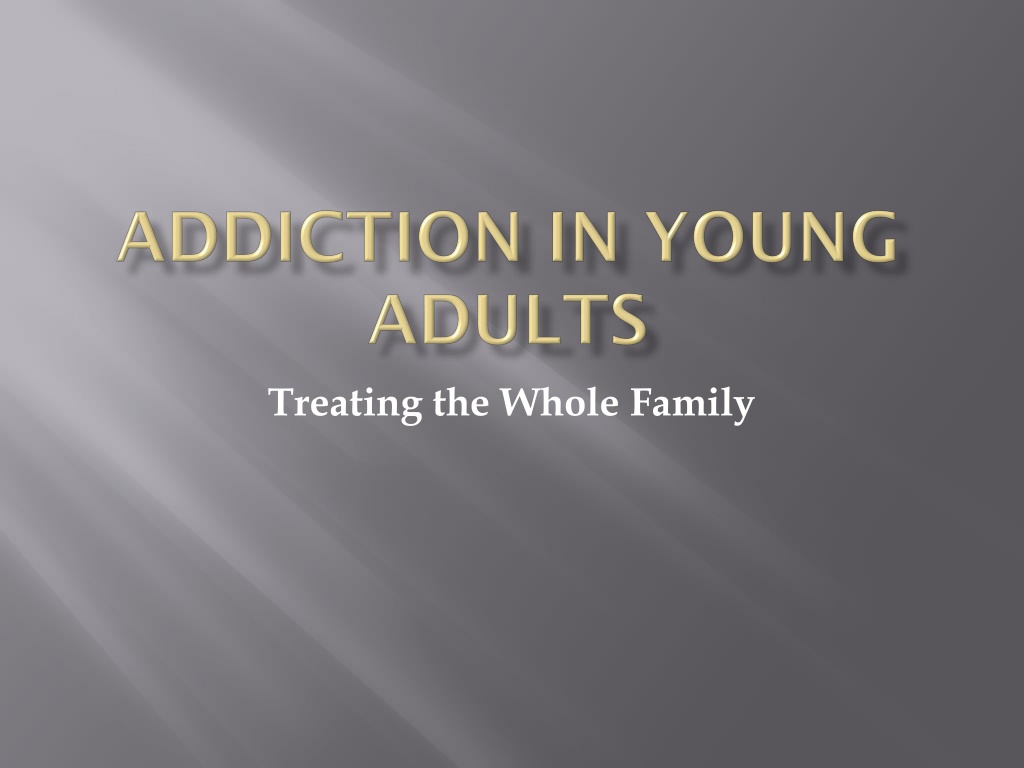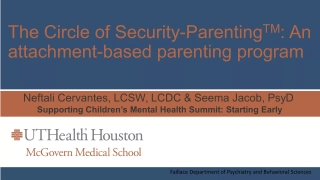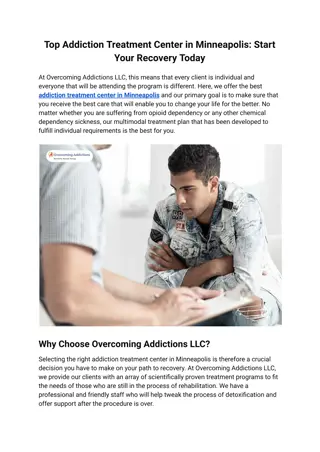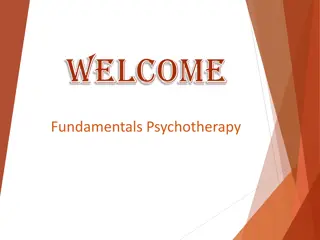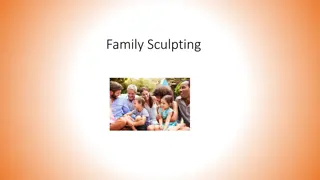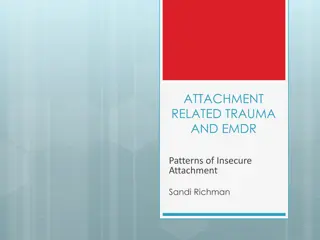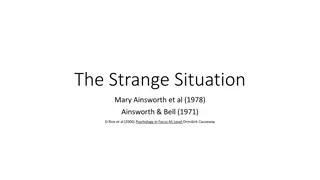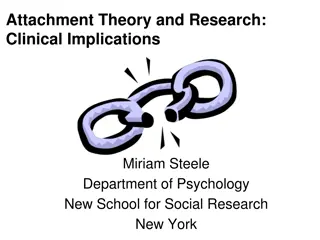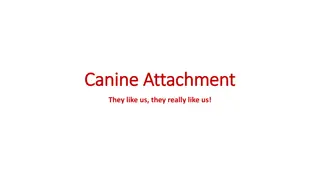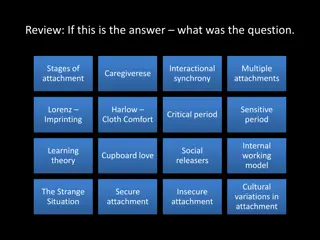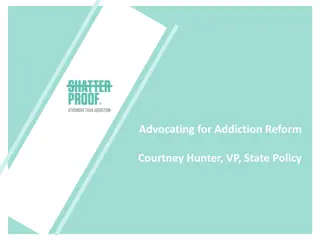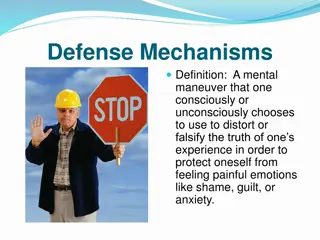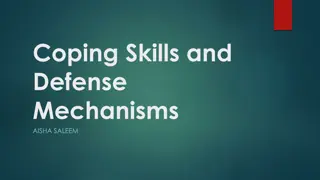Understanding Attachment, Addiction, and Defense Mechanisms in Family Therapy
Exploring the intricate relationship between attachment experiences, addiction patterns, and defense mechanisms in family therapy. Recognizing the impact of family history, stressors, and psychological responses on secure attachments, optimal brain functioning, and successful treatment outcomes.
Download Presentation

Please find below an Image/Link to download the presentation.
The content on the website is provided AS IS for your information and personal use only. It may not be sold, licensed, or shared on other websites without obtaining consent from the author. Download presentation by click this link. If you encounter any issues during the download, it is possible that the publisher has removed the file from their server.
E N D
Presentation Transcript
A maladaptive pattern of alcohol use, leading to clinically significant impairment or distress, as manifested by three or more of the following seven criteria, occurring at any time in the same 12-month period: Tolerance, as defined by either of the following: A need for markedly increased amounts of alcohol to achieve intoxication or desired effect. Markedly diminished effect with continued use of the same amount of alcohol. Withdrawal, as defined by either of the following: The characteristic withdrawal syndrome for alcohol (refer to DSM-IV for further details). Alcohol is taken to relieve or avoid withdrawal symptoms. Alcohol is often taken in larger amounts or over a longer period than was intended. There is a persistent desire or there are unsuccessful efforts to cut down or control alcohol use. A great deal of time is spent in activities necessary to obtain alcohol, use alcohol or recover from its effects. Important social, occupational, or recreational activities are given up or reduced because of alcohol use. Alcohol use is continued despite knowledge of having a persistent or recurrent physical or psychological problem that is likely to have been caused or exacerbated by the alcohol
EMOTIONS IS REGULATE THEIR OWN EMOTIONS IS DETERMINED BY THE LENGTH & STRENGTH OF THEIR EARLIEST ATTACHMENT EXPERIENCES. THE DEGREE TO WHICH A PERSON CAN REGULATE THEIR OWN THE BIOLOGICAL LIMITATIONS OF SELF REGULATION THE MANDATE FOR ATTACHMENT: INTERPERSONAL RELATIONSHIPS (SECURE ATTACHMENTS) ARE ESSENTIAL FOR OPTIMAL BRAIN FUNCTIONING. THE SAME AREA OF THE BRAIN THAT MEDIATES SEX, THIRST, HUNGER,FIGHT-FLIGHT (SURVIVAL) ALSO MEDIATES ATTACHMENT. THE CNS OF ALL SOCIAL MAMMALS IS AN OPEN FEEDBACK LOOP THE ESTABLISHMENT OF ATTACHMENT AND SECURE BASE IN THERAPY PREDICTS SUCCESSFUL TREATMENT OUTCOME. ADDICTION AS A RELATIONAL DISORDER: RELATIONSHIP WITH SELF RELATIONSHIP WITH OTHERS RELATIONSHIP WITH SOCIETY (EXISTENTIAL REALTIONSHIP)
Importance of Family HX (adult attachment questionnaire Mary Main) Family environment, relational, economic, social, psychological and health/medical stressors as barriers to secure attachment.
Defense mechanisms are a type of process or coping that results in automatic psychological responses exhibited as a means of protecting the individual against anxiety (Dziegielewski 2010). Identification and notation of defense mechanisms can be an important part of the psychological assessment and influence on the treatment process
Freud Unconscious mental processes employed by the ego to reduce anxiety
Freud's Defense Mechanisms include: Denial: claiming/believing that what is true to be actually false. Displacement: redirecting emotions to a substitute target. Intellectualization: taking an objective viewpoint. Projection: attributing uncomfortable feelings to others. Rationalization: creating false but credible justifications. Reaction Formation: overacting in the opposite way to the fear. Regression: going back to acting as a child. Repression: pushing uncomfortable thoughts into the subconscious. Sublimation: redirecting 'wrong' urges into socially acceptable actions.
Defense mechanisms (or coping styles) taken from Appendix B in DSM IV TR are automatic psychological processes that protect the individual against anxiety and from the awareness of internal or external dangers or stressors. Individuals are often unaware of these processes as they operate.
High Adaptive Level: Defense mechanisms in this group result in optimal adaptation to stress. The defenses usually maximize feelings of well being and Allow the conscious awareness of feelings, ideas, and their consequences. promote an optimum balance among conflicting motives
anticipation affiliation altruism humor self-assertion self-observation sublimation suppression
Mental Inhibition Level: Defense mechanisms in this group keep potentially threatening ideas, feelings, memories, wishes, or fears out of awareness. Diminished awareness can affect the person's ability to relate to others. displacement dissociation intellectualization isolation of affect reaction formation repression undoing
Minor image-distorting level. This level is characterized by distortions in the image of the self, body, or others that may be employed to regulate self-esteem. Examples are devaluation idealization omnipotence
Disavowal level. This level is characterized by keeping unpleasant or unacceptable stressors, impulses, ideas, affects, or responsibility out of awareness with or without a misattribution of these to external causes. Examples are denial projection rationalization
Major image-distorting level. This level is characterized by gross distortion or misattribution of the image of self or others. Examples are autistic fantasy projective identification splitting of self-image or image of others
Action Level: This level is characterized by defenses that deal with internal or external stressors by action or withdrawal. acting out apathetic withdrawal help-rejecting complaining passive aggression
Level of defensive dysregulation. This level is characterized by failure of defensive regulation to contain the individual's reaction to stressors, lead ins to a pronounced break with objective reality. Examples are delusional projection psychotic denial psychotic distortion
Family Values regarding use Social consequences and the beginning of Denial in the Family First Crisis that leads to an intervention Secondary Denial and Magical Thinking about Treatment
Behavioral, emotional and psychological containment Family as Client: identified patient as well as family members struggling with anger, resentment, shame, guilt. EDUCATION! Family systems approach; de-emphasize identified patient role, Genogram, Al-Anon and Family Therapy/support, peer coaching.
Each time we focus on the addict without focusing on the family, we are in denial that we are breaking the cycle of addiction. Parental Role: Basic needs of safety, food, shelter Appropriate role modeling, warm and supportive relationship between the parent and child, parental monitoring and supervision, maintaining awareness of the child s peer relationships, understanding the child s individual risk level and establishing appropriate parent child communication
Abandonment: When you have to hide a part of who you are in order to be acceptable/ to protect self. Emotional Abandonment When you have to hide: Your mistakes/ vulnerabilities Your feelings Your needs Your accomplishments/ success
Shame Coping Power Over Pain: Control, Rage, Perfectionism Succumb To Pain: Procrastination, Victim, Depression/Anxiety, Suicide Coping with The Pain: Addiction
Family members arent sure what they feel, so have difficulty sharing their emotions Family interactions or decisions are often focused around the addict or alcoholic Open communication is difficult, since a pattern of avoidance or denial has been set in place Blame and anger are often present, making it difficult for common solutions to be found Codependent family roles keep the addict from hitting rock bottom Family members do whatever it takes to avoid confrontation, chaos or pain
The Enabler is a helpful type, trying to rescue their child from their predicament. The Enabler wants to save the addict from the immediate crisis and relieve them of the unbearable tension created by the situation. In reality, this person is meeting a need of their own, rather than that of the addict, although the Enabler does not realize this themselves. The Enabler denies the addict the process of learning by correcting and taking responsibility for his/her own mistakes. Preventing Legitimate Suffering is the biggest form of Parental Abuse
Conflict: Aggressive, Passive and Passive Aggression and Assertiveness: enmeshment, triangulation, parentification. Boundaries and Letting GO Patient s ability to assert communication with family and find own voice is essential for individuation
DETOX FOR PHYSICAL STABILIZATION PSYCH EVALUATION/MEDICATION MANAGEMENT FOR NEUROTRANSMITTER STABILIZATION AND AFFECT REGULATION NEURO-FEEDBACK FOR NEUROLOGICAL STABILIZATIONN CBT and EMDR for TRAUMA IMPROVED COMMUNICATION AND SOCIAL SKILLS AUTONOMY TOWARDS FINANCIAL INDEPENDENCE (ABILITY TO BUDGET), SOCIAL AND PEER SUPPORT (12 STEP MEETINGS, SPONSOR) DECREASING LEVELS OF ENMESHMENTS WITH FAMILY OF ORIGIN EMPLOYMENT, EDUCATION, FINANCIAL RESPONSIBILITY
Rule In or Out of Definitive Co-occurring DX DSM definition of Remission (coincides with AA/12 Step Culture), Brain Function and full stabilization and ability to self regulate, social functioning, re-integration, personal and relational. Ongoing family and Individual work
